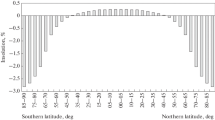Summary
The solar insolation at any point on the Earth can be expressed in terms of the latitude and longitude of that point and the parameters of the Earth's orbit. The derivation of such an equation is given here. One purpose of the equation is to gain theoretical insights into how the insolation varies on the time scales of the Milankovitch cycles. The most easily attained insights are that neither the main pacemaker of the ice agese, nor Milankovitch's precession indexe sinω appear as terms in the equation (e is the eccentricity of the Earth's orbit andω is the argument of perihelion.) Obliquity does appear. These results are already well-known, but are easily derived when the insolation is formulated as given here. The equation also suggests expressing the Earth's albedo in the same form as the insolation. When this is done a term which looks likee sinω can be made to appear, for example, multiplied by an albedo coefficient and lagged in phase. However, the term is small, of the order ofe 2. Besides theoretical insights, a second purpose of the equation is to provide a convenient formula for computing insolation when using numerical climate models. Its usefulness to this end is yet to be established.
Similar content being viewed by others
References
Berger, A., Imbrie, J., Hays, J., Kukla, G., Saltzman, B., (eds.), 1984:Milankovitch and Climate. Dordrecht, Netherlands: D. Reidel.
Caputo, M., 1967:The Gravity Field of the Earth. New York: Academic Press.
Cayley, A., 1861: Tables of the developments of functions in the theory of elliptic motion.Memoirs R. Astron. Soc.,29, 191–306.
Hays, J. D., Imbrie, J., Schackleton, N. J., 1976: Variations in the Earth's orbit: pacemaker of the ice ages.Science,194, 1121–1132.
Graves, C. E., Lee, W.-H., North, G. R., 1993: New parameterizations and sensitivities for simple climate models.J. Geophys. Res. 98, 5025–5036.
Humphreys, W. J., 1964:Physics of the Air. New York: Dover.
Kaula, W. M., 1964: Tidal dissipation by solid friction and the resulting orbital evolution.Rev. Geophys.,2, 661–685.
Kaula, W. M., 1966:Theory of Satellite Geodesy. Waltham, Mass: Blaisdell.
Laskar, J., 1988: Secular evolution of the solar system over 10 million years.Astron. Astrophys.,198, 341–362.
Liu, H.-S., 1992: Frequency variations of the Earth's obliquity and the 100-kyr ice-age cycles.Nature,358, 397–399.
Milankovitch, M., 1941: Canon of Insolation and the Ice-Age Problem, Royal Serbian Academy Special Publication 132 (English translation by the Israel Program for Scientific Translations, Jerusalem, 1969.)
North, G. R., Cahalan, R. F., Coakley, J. A., 1981: Energy balance climate models.Rev. Geophys. Space Phys.,19, 91–121.
North, G. R., Coakley, J. A., 1979: Differences between seasonal and mean annual energy balance model calculations of climate and climate sensitivity.J. Atmos. Sci.,36, 1189–1204.
Rubincam, D. P., Weiss, N. R., 1986: Earth albedo and the orbit of LAGEOS.Celest. Mech.,38, 233–296.
Short, D. A., Mengel, J. G., Crowley, T. J., Hyde, W. T., North, G. R., 1991: Filtering of Milankovitch cycles by Earth's geography.Quat. Res.,35, 157–173.
Stephens, G. L., Campbell, G. G., Vonder Haar, T. J., 1981: Earth radiations budgets.J. Geophys. Res.,86, 9739–9760.
Taylor, K. E., 1984: Fourier representations of orbitally induced perturbations in seasonal insolation. In: Berger, A. L., Imbrie, J., Hays, J., Kukla, G., Saltzman, B. (eds.)Milankovitch and Climate, pp. 113–125. Netherlands: Dordrecht, D. Reidel.
Vernekar, A. D., 1972: Long-period global variations of incoming solar radiation.Meteorological Monographs,12, [34].
Ward, W. R., 1974. Climate variations on Mars 1. Astronomical theory of insolation.J. Geophys. Res.,79, 3375–3386.
Willson, R. C., Hudson, H. S., 1988: Solar luminosity variations in solar cycle 21.Nature,322, 810–812.
Author information
Authors and Affiliations
Additional information
With 3 Figures
Rights and permissions
About this article
Cite this article
Rubincam, D.P. Insolation in terms of Earth's orbital parameters. Theor Appl Climatol 48, 195–202 (1994). https://doi.org/10.1007/BF00867049
Received:
Revised:
Issue Date:
DOI: https://doi.org/10.1007/BF00867049




